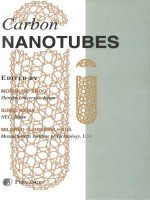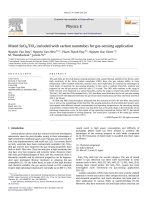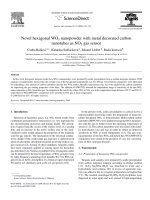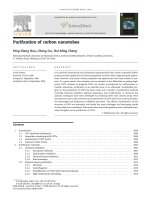Carbon nanotubes as nanofillers
Bạn đang xem bản rút gọn của tài liệu. Xem và tải ngay bản đầy đủ của tài liệu tại đây (3.08 MB, 38 trang )
Outline
I. Polymer microcomposites filled with microparticles
I.1. Mechanical melt blends
I.2. Importance of « polymer/filler » interface (tension and adhesion)
I.3. "Polymerization-filled composites" PFC's
II. Polymer nanocomposites filled with nanoparticles
II.1. Layered silicate as nanofillers
- Polymer-clay nanocomposites : melt blending
vs.
in situ
polymerization
- Polyolefinic matrices : role of matrices and compatibility
- Polyester matrices : role of clays and organo-modification
II.2. Carbon nanotubes as nanofillers
- Polymer-CNTs composites : production and properties
- « Melt blending » technique, e.g., in elastomeric matrices
-
in situ
polymerization, e.g., in thermoplastic matrices
III. General conclusions et outlook
Chapter 3 :
Polymer nanocomposites filled with nanoparticles
Part II. Carbon nanotubes as
nanofillers
Allotropic forms of Carbon
Curl, Kroto, Smalley 1985
Iijima 1991
graphene
(From R. Smalley´s web image gallery)
- Single-wall nanotubes (SWNTs)
- Multi-wall nanotubes (MWNTs)
Carbon Nanotubes
~ 1-2 nm
Few microns
TEM images of various MWNTs
~ 2 - 50 nm
Properties of CNT
•
Electrical :
–
High electric conductivity (higher than copper)
–
Easy process for Conductive Semi-conductive
•
Thermal :
–
High thermal conductivity (higher than silicon)
–
Stable at high temperature
•
Physical :
–
100 times stronger than steel but very light
–
Elastic behavior (Pressing CNT tip bend and recover to
its original state)
•
Chemical :
–
Rarely react with other compounds
–
Chemically stable
(a) Conductive
(b) Semiconductive
(c) Diode
‘Kink CNT’: divide conductive
and semi-conductive
Synthesis methods of CNT
•
Arc discharge
–
First CNT synthesis method used by Dr.Iijima
–
Arc is formed in the gap between two graphite
electrodes
–
Grow SWNT with catalyst (Co, Ni, Fe, Y, etc.),
while MWNT without catalyst metal
–
Usual conditions :
•
400~700 torr (use He gas)
•
20~30 V between electrodes
•
1mm distance between electrodes
•
50~100 A
–
For higher purity:
•
Rotate cathode to uniform the arc
•
High the temperature
•
Use Hydrogen gas instead Helium gas
Synthesis methods of CNT (cont’)
•
Laser vaporization
–
First used Smalley Group in 1995
–
Use He or Ar gas and maintain 500 torr
–
Use laser, vaporize graphite.
Synthesis methods of CNT (cont’)
CVD (Chemical vapor deposition)
–
Advantages : temperature, the insert gas, pressure, gas flow, catalyst,
etc.
–
Insert hydrocarbon gas (C
2
H
2
, C
2
H
4
, CH
4
, etc) into
quartz tube and obtain Energy
insert gas decomposed and CNT grow on a quartz boat surface.
–
Energy source categorizes CVD
: thermal CVD, Hot filament plasma CVD, Microwave plasma CVD, RF
plasma CVD, etc.
Synthesis methods of CNT (cont’)
•
CVD
–
Thermal CVD
–
uses C
2
H
2
gas and Ni, Fe, Co or all
together as a catalyst.
– Implementation is easy
– Grow large uniform CNT at high
temperature (over 800
o
C).
– Use mixture of Pd and Ni for substrate to
maintain the high temperature condition
can grow high purity CNT vertically
under 600
o
C
Mechanic properties : high tenacity
Mechanic properties : high tenacity
Electrical properties :
Electrical properties :
Electronic components, sensors,…
Tensile strength (GPa)
Carbon nanotubes
Carbon fibers
Tenacity
Tenacity
Reinforcement of polymeric matrix
(nano)composites
HDPE : 0.023 GPa
Thermal properties : « stability » and flame retardant behavior
Thermal properties : « stability » and flame retardant behavior
Interest of
carbon nanotubes
as nanofillers
Difficulty : Bundle-like aggregation of CNT’s
SEM of MWNTs
20 µm
TEM of MWNTs
200 nm
TEM of SWNTs : axial view
-
hexagonal distribution
-
high cohesion between nanotubes
5 nm
Bundle-like aggregation maintained upon melt blending within
polymer matrix
500 nm
EVA + MWNT’s
Bundle-like
aggregates
µm-size > thousands
bundle aggregates individual tubes
The Processing Challenge
Polymer
Proposed solution : CNT surface FUNCTIONALIZATION
Sun Y-P., Acc. Chem. Res., 35, 1096 (2002)
Easier dispersion in polymeric matrices…
Carbon nanotubes as nanofillers
Production of nanocomposites by « Melt
blending » technique :
Use of organo-clays to separate the CNT’s









